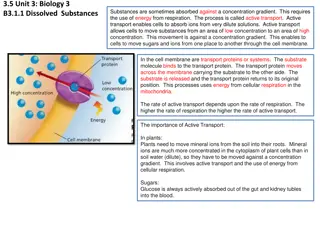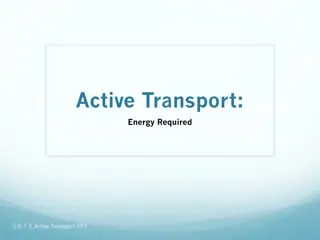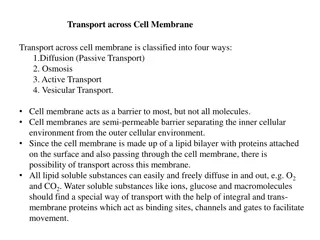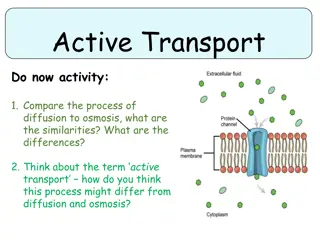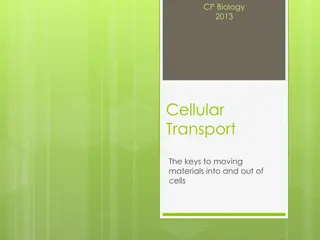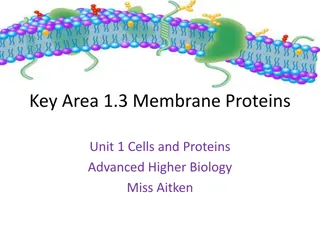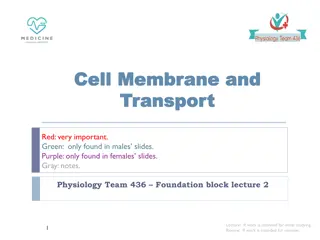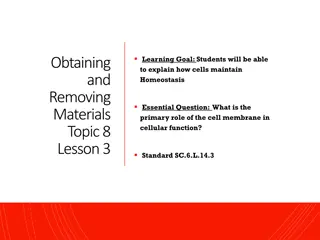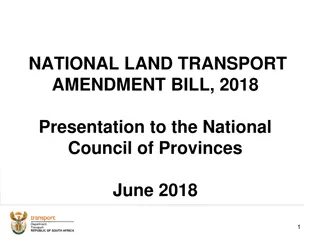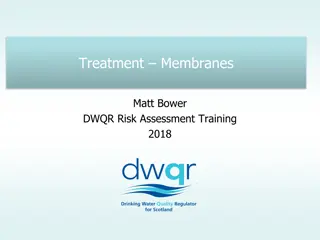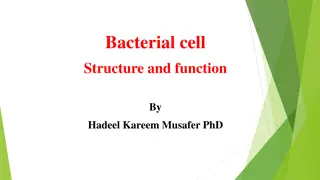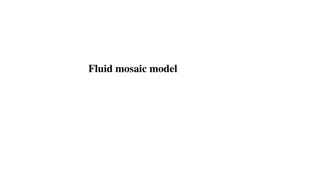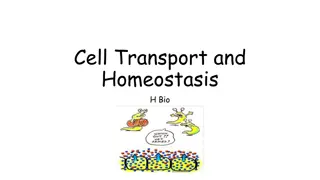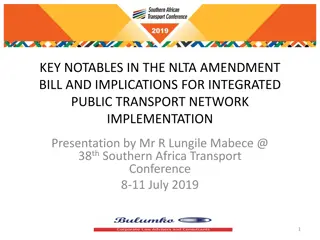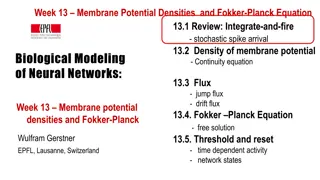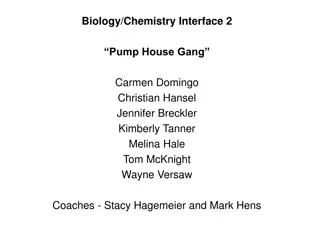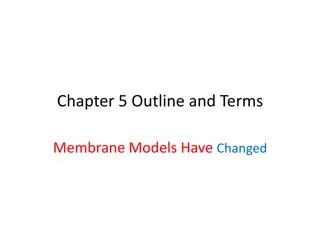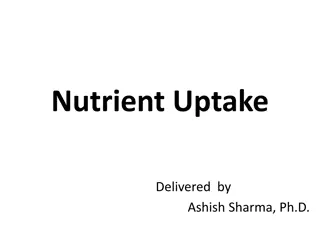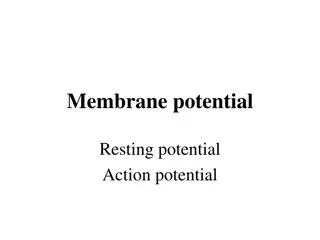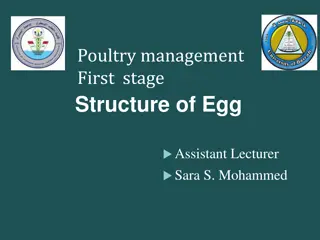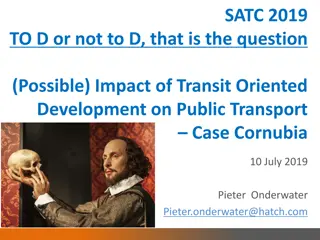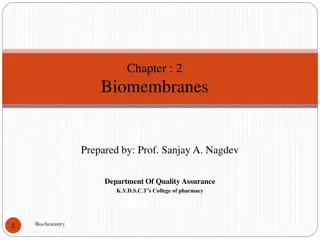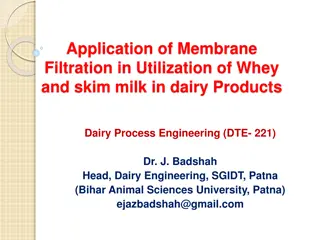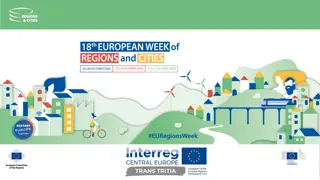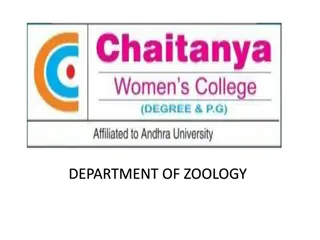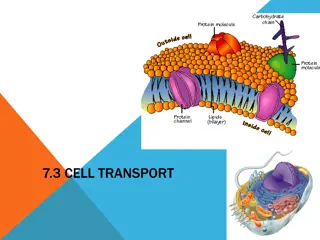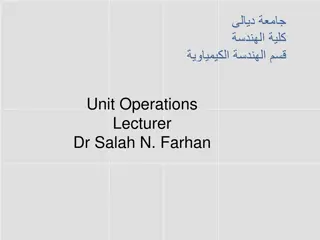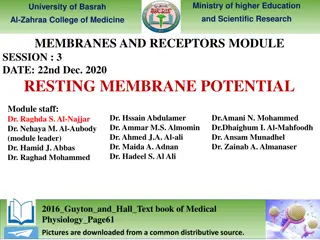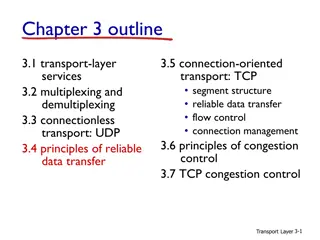The Cell Membrane: Structure and Function
The cell membrane is essential for life, defining cell boundaries, maintaining internal conditions, and regulating substance transport. Composed of lipids and proteins, this dynamic structure allows for selective permeability. Explore its importance in cellular processes.
4 views • 30 slides
Active Transport and Osmosis in Biology
Substances can be absorbed against concentration gradients through active transport, requiring energy from respiration. Cells use transport proteins to move substances across membranes. Osmosis involves the movement of water across a selectively permeable membrane along concentration gradients. The
4 views • 12 slides
Active Transport: Energy-Driven Cellular Processes
Active transport is a vital process in cells that require energy in the form of ATP to move materials across the plasma membrane against their concentration gradient. This process involves pumps, endocytosis, and exocytosis. The sodium-potassium pump in nerve cells is a classic example of active tra
0 views • 9 slides
Cell Membrane Transport: Diffusion and Facilitated Diffusion
Cell membrane transport plays a crucial role in maintaining cellular functions by regulating the movement of substances across the membrane. Diffusion, a passive transport process, allows molecules to move from areas of high concentration to low concentration without energy expenditure. Within diffu
2 views • 20 slides
Passive and Active Transport in Cells
Explore the processes of diffusion, osmosis, and active transport in cells. Understand the similarities and differences between them, and learn why active transport is crucial for living organisms. Watch a video on active transport and answer related questions to deepen your knowledge. Enhance your
2 views • 12 slides
Cellular Transport and the Role of Cell Membrane
Explore the process of cellular transport, where materials are exchanged between organisms and their environments. Discover the types of materials transported into and out of cells, from water to waste materials. Delve into the significance of the cell membrane as the final point of transfer and its
0 views • 61 slides
Membrane Proteins and Cell Membrane Permeability
Cell membranes consist of phospholipid bilayers with embedded proteins, including integral and peripheral proteins. Integral proteins span the membrane, while peripheral proteins interact with the surface. Only non-polar molecules can pass through the membrane directly, while charged ions, polar mol
0 views • 30 slides
Cell Membrane Structure and Function
This educational content delves into the structure and function of the cell membrane, covering topics such as the fluid mosaic model, permeability, carrier-mediated processes, and membrane proteins. It explains the composition of the cell membrane, selective permeability, and the roles of integral a
2 views • 36 slides
Comprehensive Overview of Treatment Membranes in Water Quality Risk Assessment Training
Comprehensive overview of treatment membranes in water quality risk assessment training, covering various membrane types, applications, and considerations. Membranes play a crucial role in removing a range of contaminants from water sources, with different membrane types suited for specific applicat
0 views • 9 slides
Cell Membrane: Maintaining Homeostasis in Cells
Cells maintain homeostasis to function effectively. The cell membrane plays a crucial role in this process by regulating material exchange, separating the cell from its environment, and ensuring internal balance. Understanding how cells exchange materials through the membrane is key to comprehending
1 views • 16 slides
HyTrEc2: Advancing Hydrogen Transport Economy in the North Sea Region
HyTrEc2, a project under the Interreg VB North Sea Programme, aims to promote green transport and mobility by implementing innovative hydrogen transportation solutions. With a vision to stimulate hydrogen-fueled transport for a sustainable future, the project focuses on developing zero-emission solu
0 views • 23 slides
Mechanisms of Nutrient Uptake by Microbial Cells
Nutrient uptake by microbial cells involves various transport mechanisms such as passive diffusion, facilitated diffusion, active transport, and group translocation. These mechanisms ensure the specific acquisition of required nutrients by the cell through the selectively permeable plasma membrane.
3 views • 15 slides
National Land Transport Amendment Bill 2018 Overview
The National Land Transport Amendment Bill of 2018 aims to address developments in the land transport system since 2009. It includes provisions for non-motorised and accessible transport, revises public transport contracting arrangements, clarifies government functions, streamlines operating license
1 views • 44 slides
Membrane Treatment in Water Filtration Systems
Membrane treatment plays a crucial role in water filtration systems by removing various contaminants such as turbidity, microbiology, and chemical impurities. This overview covers different types of membranes like plate and frame, spiral wound, tubular, and hollow fiber, highlighting their functions
0 views • 9 slides
Bacterial Cell Structure and Function
Bacteria display unique cellular structures and functions that differ from eukaryotic cells. They have a simple structure with a plasma membrane but lack complex internal membrane systems. The cytoplasm contains inclusion bodies, ribosomes, and genetic material in the nucleoid. Bacteria can be categ
4 views • 21 slides
The Fluid Mosaic Model of Plasma Membrane Structure
The fluid mosaic model proposed by S.J. Singer and Garth L. Nicolson describes the structure of the plasma membrane as a fluid combination of phospholipids, cholesterol, proteins, and carbohydrates. This model explains how phospholipids form a stable barrier, the role of saturated and unsaturated fa
2 views • 6 slides
Osmosis and Cell Membrane Transport
Osmosis is the process of water molecules diffusing across a semi-permeable membrane, crucial for maintaining cell function. It involves the movement of water from areas of high concentration to low concentration until equilibrium is reached. Special proteins called aquaporins facilitate water trans
1 views • 24 slides
Cell Transport and Homeostasis in Biology
Delve into the world of cell transport and homeostasis, exploring the functions of the cell membrane, the molecules involved, the fluid mosaic model, and passive transport mechanisms like diffusion, osmosis, and facilitated diffusion. Learn about the intricacies of maintaining equilibrium within cel
0 views • 10 slides
Key Notables in NLTA Amendment Bill for Integrated Transport Network
Presentation by Mr. R. Lungile Mabece at the 38th Southern Africa Transport Conference focusing on notable changes in the National Land Transport Act (NLTA) Amendment Bill and implications for implementing an Integrated Public Transport Network (IPTN). The presentation discusses key developments, im
1 views • 16 slides
Membrane Potential Densities and the Fokker-Planck Equation in Neural Networks
Delve into the concepts of membrane potential densities and the Fokker-Planck Equation in neural networks, covering topics such as integrate-and-fire with stochastic spike arrival, continuity equation for membrane potential density, jump and drift flux, and the intriguing Fokker-Planck Equation.
0 views • 29 slides
Cellular Membrane Transport in Biology/Chemistry Interface 2
Explore the teachable unit on membrane transport in an introductory biology class for majors to understand how cells exchange substances with their environment. The unit covers selective membrane permeability, membrane transport mechanisms, proteins involved, physiological importance, and outcomes o
0 views • 23 slides
Evolution of Membrane Models: From Early Observations to Fluid-Mosaic Structure
Researchers in the early 20th century noted the permeability of lipid-soluble molecules into cells, paving the way for membrane studies. The development of membrane models progressed from the sandwich model to the widely accepted fluid-mosaic model. The complexity of the plasma membrane, comprising
0 views • 22 slides
Membrane Transport Processes in Plant Cells
Plant cells are separated from the environment by plasma membranes, which facilitate the movement of molecules through passive and active transport mechanisms. Transport proteins play a crucial role in allowing the movement of ions and polar molecules, with channels, carriers, and pumps enhancing so
0 views • 20 slides
Membrane Potential and Action Potentials in Excitable Cells
Membrane potential, resting potential, and action potentials play crucial roles in the functioning of excitable cells like neurons, muscle cells, and endocrine cells. Voltage-gated channels, depolarization, and repolarization are key processes involved in generating and propagating action potentials
1 views • 26 slides
Comprehensive Overview of Transport Operations
Explore the various aspects of transport management including mechanisms for ensuring a smooth flow of goods, freight characteristics, criteria for selecting vehicles, lorry fleet management, ground transport capacities, and factors influencing transport decisions. Learn about managing lorry fleets,
0 views • 10 slides
Membrane Transport in Plant Cells
Plant cells rely on membrane transport to facilitate the movement of molecules across their plasma membrane. This process involves passive and active transport mechanisms, with the help of specialized proteins such as channels, carriers, and pumps. Channels serve as selective pores for ions and wate
0 views • 20 slides
Uganda Transport Sector Development Partners Group Priorities FY 19/20
This document outlines key priorities identified by the Uganda Transport Sector Development Partners Group for the fiscal year 2019/2020. The priorities include institutional framework optimization, legislative reforms, preparation of policy reports, and capacity-building initiatives within the tran
2 views • 6 slides
Comparison of Eukaryotic and Prokaryotic Cells in Cell Biology
Cells are the fundamental units of life, but viruses are an exception as they lack cells. Eukaryotic cells have a defined nucleus with a nuclear membrane housing chromosomes, while prokaryotic cells lack a membrane-bound nucleus and other organelles. Eukaryotic cells are larger, containing membrane-
0 views • 9 slides
Structure of Eggs in Poultry Management
Eggs in poultry management consist of the yolk, albumen, shell membrane, and shell. The yolk is the yellow center surrounded by the vitelline membrane. The albumen makes up most of the egg and has two layers - outer thin white and inner thick white with chalazae. The shell membrane and shell protect
0 views • 14 slides
Impact of Transit Oriented Development on Public Transport: Case Cornubia
Investigate the influence of Transit Oriented Development (TOD) factors on the public transport system, including improved public transport density, mixed-use design, and pedestrian-friendly infrastructure. This paper explores the theoretical application of TOD in urban planning with a focus on the
0 views • 16 slides
Biomembranes: Composition, Structure, and Functions
Biomembranes, specifically the plasma membrane, play a crucial role in cell function by separating and protecting the cell, facilitating communication with the environment, and regulating transport processes. Composed of lipids, proteins, and carbohydrates, membranes have a fluid mosaic structure wi
0 views • 13 slides
Membrane Filtration in Dairy Products: Utilization of Whey and Skim Milk
Utilizing membrane filtration in dairy processing transforms whey, a byproduct of cheese production, into valuable products like refined proteins. Ultrafiltration (UF) allows for the fractionation of whey into protein-rich and lactose-containing streams, increasing protein content significantly. The
0 views • 11 slides
Enhancing Freight Transport Coordination in Trans Tritia Project Territory
Improving freight transport coordination and planning in the Trans Tritia project territory covering Poland, Czech Republic, Slovakia, and specific regions aims to address territorial challenges, enhance regional integration, and foster cross-border cooperation. The project, co-financed by the Europ
0 views • 15 slides
The Composition and Function of the Plasma Membrane in Animal Cells
The plasma membrane is a vital component of animal cells, serving as a barrier that regulates the passage of substances. Composed mainly of lipids and proteins, it plays a crucial role in cell structure and function. This article explores the chemical composition, molecular structure, and significan
0 views • 16 slides
7.3 CELL TRANSPORT
The cell membrane plays a crucial role in maintaining homeostasis by regulating the flow of materials in and out of the cell. Passive transport processes like diffusion, osmosis, and facilitated diffusion move molecules across the membrane without requiring energy. Learn about hypertonic, hypotonic,
0 views • 19 slides
Transport of Small Molecules
The internal composition of a cell is maintained by the selectively permeable plasma membrane, allowing control over molecule exchange. Passive diffusion, mediated by transport proteins, permits small molecules to cross the membrane easily. However, larger polar or charged molecules require specific
0 views • 48 slides
Introduction to Membrane Separation Processes
Membrane separation processes utilize semi-permeable membranes to selectively separate molecules based on size, affinity, or charge. This natural phenomenon offers advantages such as continuous separation and low energy requirements, although fouling can be a concern. Learn about the types of membra
0 views • 41 slides
Membrane Fluidity and Adaptability
This presentation delves into the dynamic nature of cell membranes, focusing on membrane fluidity and its impact on membrane function. Explore the chemical structure underlying membrane adaptability, lipid composition changes in extreme environments, and the role of Omega-3 fatty acids. Discover how
0 views • 22 slides
RESTING MEMBRANE POTENTIAL
This session delves into the factors influencing the unequal distribution of ions, the impact on membrane potential, Nernst equations for calculating equilibrium potentials, and the role of ion permeability and Na+-K+-ATPase in resting membrane potential maintenance. Explore the effects of ion condu
0 views • 11 slides
Transport Layer Services: Multiplexing, Demultiplexing, and Reliable Data Transfer
In this chapter outline, we delve into the essential elements of transport layer services, including multiplexing and demultiplexing, UDP for connectionless transport, reliable data transfer principles, TCP for connection-oriented transport, congestion control, and TCP congestion control. The import
0 views • 36 slides

